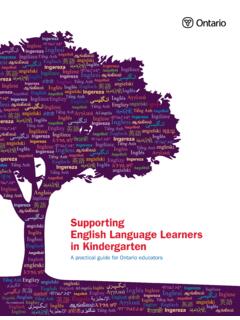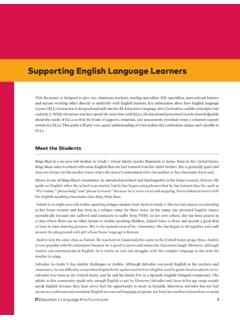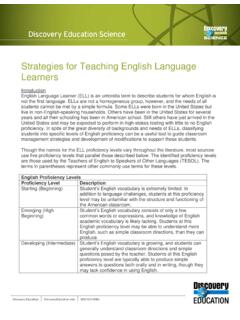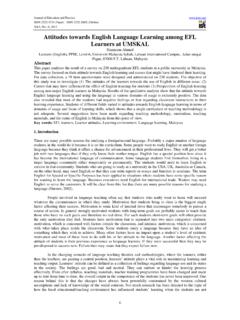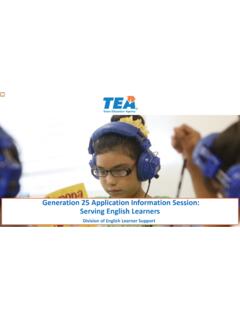Transcription of Performance Assessments for English Language Learners
1 Performance Assessments for English Language Learners oStanford Center for Opportunity Policy in EducationsceStanford Center for Opportunity Policy in EducationJamal AbediStanford Center for Opportunity Policy in EducationBarnum Center, 505 Lasuen MallStanford, California 94305 Phone: study was conducted by the Stanford Center for Opportunity Policy in Education (SCOPE) with support from the Ford Foundation and the Nellie Mae Education Foundation. 2010 Stanford Center for Opportunity Policy in Education. All rights Stanford Center for Opportunity Policy in Education (SCOPE) supports cross-disciplinary research, policy analysis, and practice that address issues of educational opportunity, access, equity, and diversity in the United States and internationally.
2 Citation: Abedi, J. (2010). Performance Assessments for English Language Learners . Stanford, CA: Stanford University, Stanford Center for Opportunity Policy in Education. oStanford Center for Opportunity Policy in EducationscePerformance Assessments for English Language Learners .. 1 Why Performance Assessments for English Language Learners ? .. 6 Improving Teaching Quality for English Learners Through Performance Assessments .. 12 How Performance Assessments Can Be Made Most Valid for English Language Learners .. 17 Summary and Discussion .. 21 References .. 23 Appendix: Sample PAT Response and Rubric .. 27 Table of ContentsStanford Center for Opportunity Policy in EducationAbstractStandardized achievement tests that are used for assessment and accountability purposes may not provide reliable and valid outcomes for English Language Learners (ELLs) because extraneous sources may confound the outcome of Assessments for these students.
3 Performance Assessments , by contrast, may offer opportunities for these students to present a more comprehensive picture of what they know and are able to do. In this paper, we discuss limitations with the standardized achievement tests currently used for ELLs and share information on how Performance Assessments can be efficiently used to lead to better understanding of these students content knowledge and to improve their academic Performance . Issues and limitations of a Performance assessment approach for ELL students are discussed, along with how to make these Assessments more accessible to ELL author would like to acknowledge the contribution of Nancy Ewers, a graduate research assistant at the University of California, Davis, for her help-ful editing, comments, and Assessments for English Language LearnersPerformance Assessments for English Language Learners raditional standardized achievement test outcomes are used for high-stakes deci-sions in assessment and accountability systems throughout the United States.
4 Often developed and field tested for the mainstream student population, these assess-ments may not be sensitive enough to the needs of some subgroups of students, such as English Language Learners (ELLs), who are faced with challenging academic careers. Research clearly demonstrates that some variables unrelated to the focal measurement construct ( , unnecessary linguistic complexity, cultural biases in construction of items) can affect the quality of high-stakes Assessments for these students (Abedi, 2006; Solano-Flores & Li, 2006; Solano-Flores & Trumbull, 2003; Solano-Flores, 2008). Therefore, the outcomes of these Assessments may not be reliable and valid, and they may not yield sufficient evidence for making important decisions regarding a student s academic career.
5 Despite efforts to make state and national standardized achievement tests more accessible for English Language Learners , the outcomes of these Assessments may not be useful in evaluating student learning and informing instruction due to their inherent limitations. Conducted mainly for accountability purposes, these end-of-year assess-ments do not afford an opportunity for students to present a comprehensive picture of what they know and are able to do in content areas such as math, science, and reading/ Language arts. More importantly, accountability is not only about measuring student learning, but actually improving it (Darling-Hammond, 2004, p. 1078). Performance Assessments can help to fill this gap, because they not only engage these students and give them a chance to demonstrate their knowledge but also disclose more in-depth information on students academic needs.
6 Performance Assessments can be less affected by unnecessary linguistic complexity for two reasons. First, Language is often not the only medium of presenting an assessment task. For example, in a science hands-on Performance task, students are presented with a set of physical materials (batteries, wires, and bulbs as in Figure 1 (see page 2), or pencil and salt and fresh water as in Figure 2, page 3). Second, students have access to these physical materials as they formulate assessment responses thereby reducing reliance on Language . In science, students can experience manipulation of hands-on objects and use that familiarity as they formulate written or oral responses. Performance Assessments thus reduce linguis-tic complexity as tasks are presented and as responses are prepared.
7 This report describes how Performance Assessments can help the ELL student popula-tion demonstrate what they know and are able to do. Unfortunately, research literature on Performance Assessments for English Language Learners is thin, but it offers evidence on the effectiveness and usefulness of Performance Assessments for these Center for Opportunity Policy in EducationFigure 1. Electric Mysteries Performance AssessmentPerformance Assessments and English Language LearnersBass, Magone, and Glaser (2002) observe that Performance Assessments allow all stu-dents, especially those with different Language backgrounds, to engage in cognitively complex activities such as generating strategies, monitoring work, analyzing information, and applying reasoning the same time, assessment experts may argue that for ELL students, Performance assessment items may not fully reflect content knowledge and may be confounded with writing skill and vocabulary.
8 That is, Language factors in Performance Assessments may even have a greater level of impact on ELL student Performance than for native speakers of English . In response to this concern, a distinction should be made between Language related to the construct being measured (construct-relevant) and Language not necessarily relevant to the content (construct-irrelevant). In Performance Assessments , students actual Performance rather than their expressive Language may more clearly convey the content being measured. For example, in the floating pencil exercise (see Figure 2, page 3, for a description), students not only hear the test instruction to measure the length of a pencil floating in both fresh and salt water but also see the pencil under both condi-tions.
9 More importantly, since the object of measurement is presented in multiple sensory modes (floating pencil and fresh and salt water), Language is not the only way to present the Performance assessment task (PAT) and obtain student Linn and Burton (1994, p. 5) have indicated, Performance Assessments have appeal as Assessments that better reflect good instructional activities, are often thought to be more engaging for students, and are better reflections of criterion performances that are of importance outside the classroom ( , they are said to be more authentic). Electric Mysteries: Student determines what is inside an electric mystery box by constructing and reasoning about circuits. Scoring is evidenced based, focusing on evidence and explanation (Ayala et al.)
10 , 2001, p. 25). 3 Performance Assessments for English Language LearnersSimilarly, as Darling-Hammond (2006) indicates: Performance Assessments that require students to evaluate and solve complex problems, conduct research, write extensively, and demonstrate their learning in projects, papers, and exhibitions have proven key to mo-tivating students and attaining high levels of learning in redesigned high schools (p. 655).Increasing the level of motivation is important for English Learners because they need encouragement and support in their academic clearly demonstrates that Language factors have a major impact on the out-comes of Assessments for English Language Learners (Solano-Flores & Li, 2006; Solano-Flores & Trumbull, 2003; Solano-Flores, 2008).

